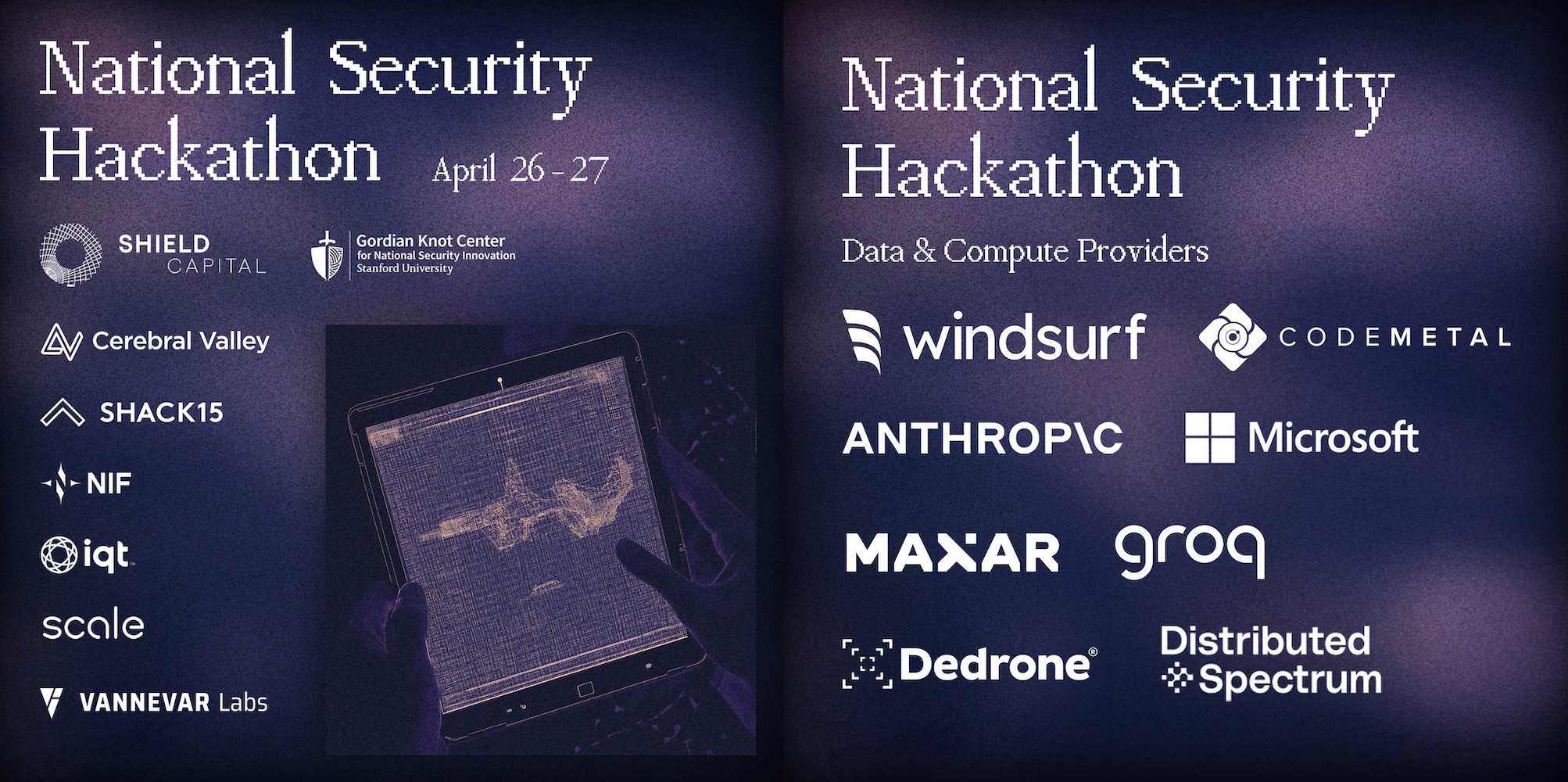监护网 SF

关于
监护网(SF)是一个智能城市紧急疏散工具,帮助社区在重大灾害期间快速安全地响应。该系统允许城市管理员或紧急官员在互动地图上标记危险区域,例如受自然灾害影响的地区,并定义安全区域。然后使用先进的路径寻找算法生成并传达居民的最安全疏散路线,同时考虑当前的危险。
当发生紧急情况时,官员可以更新危险和安全区域,并立即通过短信向居民的手机发送警报。每个人都会收到一个链接到网络门户,该门户使用他们当前的位置显示一条危险意识的安全路线,并提供与 Google Maps 的即时方向。随着情况的发展,路线会实时重新计算,并发送新的警报以保持每个人的更新和安全。请在此查看演示:
在当前的演示代码中,警报通过短信发送到一个电话号码以进行演示和测试目的。然而,在实际部署中,监护网 SF 将与 无线紧急警报(WEA)系统 集成,以向受影响城市或地区的所有人广播疏散警报。

虽然目前的重点是旧金山湾区,但我们的愿景是将监护网扩展到世界其他主要城市。我们的目标是提供一个强大的系统,以便协调和数据驱动的疏散,使每个城市都能保护其人民,减少拥堵,并在紧急情况发生时快速响应。
Aspen 团队

监护网是由 Aspen 团队在国家安全黑客马拉松上开发的。我们的团队包括:
我们感谢我们的导师和组织者的指导和支持,包括埃利奥特·沃尔夫、亚当·帕帕和雷·德尔·维基奥。

我们的黑客马拉松之旅
2025年4月26日至27日的黑客马拉松周末带来了意想不到但强大的合作。我的好朋友 迪伦·埃克 和我分别从科罗拉多州和密苏里州出发,参加了 Cerebral Valley 在旧金山举办的第二届国家安全黑客马拉松。在活动启动时,我们遇到了 克里斯蒂娜·黄 和 伊奥娜·穆特亚努,Aspen 团队由此诞生。

伊奥娜的 LinkedIn 帖子,突显了我们的黑客马拉松经历
黑客马拉松提出了两个不同的挑战。主要赛道是一个基于项目的竞争,设有传统的名次奖,而一个特别挑战邀请参与者道德黑客 Code Metal 的冷却系统。鉴于我们团队的多样化专业知识,特别是迪伦在软件和机械工程方面的背景,我们做出了在24小时内同时应对两个挑战的战略决定。
这种雄心勃勃的方法导致了两个重要的结果:
-
监护网(SF) - 我们的主要黑客马拉松项目专注于紧急疏散:
-
Code Metal 挑战 - 我们成功进行了对其冷却系统的最成功渗透测试,赢得了5000美元的特别奖。虽然这个解决方案仍然是保密的,但它展示了我们团队在软件和热力学系统方面的技术深度。
虽然监护网没有在主要比赛中获得前三名,但评委们认可了其潜在影响和创新方法。该项目的范围雄心勃勃,分散在两个挑战之间的关注意味着我们无法在时间限制内实施所有设想的功能。尽管如此,评委的反馈验证了我们解决城市应急管理问题的解决方案的重要性。
黑客马拉松证明是一次变革性的经历。除了技术成就和奖金外,它还促进了新友谊,并展示了在压力下多样化技能组合的力量。在经历了2024年底和2025年初的个人挑战后,这一成功尤其有意义并令人振奋。



黑客马拉松详情

监护网(SF)是在第二届年度 国家安全黑客马拉松(2025年4月26日至27日)上构建的,由 Cerebral Valley 和 Shield Capital 主办,并与斯坦福 DEFCON 合作。该活动汇集了技术人员和工程师,构建解决美国军方利益相关者策划的国家安全问题声明的解决方案,并得到政府、军方和初创企业导师的指导。
- 周末包括在斯坦福大学的国防技术职业博览会和团队建设,随后在旧金山进行了24小时的黑客活动。
- 赞助商和支持者包括 Shield Capital、In-Q-Tel、北约创新基金、Vannevar Labs、Scale AI、Groq、Windsurf、Anthropic、微软、Maxar、Dedrone、Distributed Spectrum 和 Code Metal。
- 黑客马拉松类别包括智能城市、战争游戏、海事模式分析、人工智能部署的网络安全、射频导航、一般国家安全和黑客冷却系统。
黑客马拉松的主要部分的奖品包括第一名3000美元和Starlink设备,第二名2000美元,第三名1000美元。但还有一个特别的隐藏奖项,冷却挑战的奖金为5000美元。
我们的团队参加了 智能城市 和 黑客冷却系统 挑战。监护网(SF)是我们的智能城市参赛作品。我们在冷却挑战中获得了5000美元的特别奖和荣誉提名,我们的智能城市解决方案也得到了评委和同行的强烈反馈。
评委和同行们认为监护网(SF)是对紧急管理中一个重大问题的有影响力的回应,赞扬了它的创造力、实用方法,以及它避免仅仅使用 LLM 技术作为万用解决方案的事实。尽管我们的智能城市项目由于在两个挑战之间分散资源而未能获得前三名奖项,但评委们对其潜力和相关性印象深刻。我们的团队很荣幸获得这一认可,并赢得了 黑客冷却系统 挑战。
在我们的 LinkedIn 帖子 中找到更多细节和反思,并在 这里 查看黑客马拉松的照片画廊。
GPS 数据源
为了在旧金山湾区进行路径寻找和地图绘制,我们需要精确和全面的道路数据。我们最初尝试使用 Google Maps API 和 Mapbox 的 API 来检索这些数据。然而,他们的许可限制和功能限制阻止我们以符合黑客马拉松目标的方式获取或使用底层路由图。由于这些限制,我们使用了开放的原始地理数据集。我们通过这两个开源来源获得了这些原始地理数据:
线性特征代表旧金山湾区的道路。该特征集是通过大都会交通委员会(MTC/ABAG)使用所有基于县的2021年TIGER/Line形状文件组装而成。该数据集包括整个地区的所有主要、次要、地方社区和乡村道路、城市街道、车辆小径、坡道、服务车道、小巷、私人道路、自行车道、马道、步道和楼梯。
- 特征集包含每个县的独特道路段,并包括单段道路具有多个名称的情况(例如,一条州际公路同时被称为其编号和地方名称)。
- 主要道路是主要的分隔高速公路,而次要道路是该地区的主要干道。
- 数据集包括用于识别道路类型、管辖权等的属性列,支持灵活的路由和数据分析。
您可以在MTC数据集来源阅读更多关于许可和数据的详细信息。
如何运行
-
克隆此存储库并导航到其中。
-
设置您的
.env.local文件。请参考env.local.example文件以了解您需要哪些环境变量。请注意,您需要一个MapBox API密钥用于地图用户界面和地理编码,一个TextBelt API密钥用于短信警报(仅限演示),以及一个用于演示期间发送短信的电话号码。 -
创建
.env.local文件后,您可以开始设置GuardianGrid的所有服务,包括:- frontend:应用程序的前端界面。
- backend:应用程序的后端,包括地图路径查找逻辑。
-
要设置frontend服务,请确保您已安装Yarn并运行:
yarn install -
要设置backend服务,请执行以下操作:
# 进入此目录 cd ./src/backend # 设置python环境 python3 -m venv env # 激活python环境 source env/bin/activate # 安装依赖 pip3 install -r requirements.txt # 关闭python环境 deactivate # 返回项目根目录 cd - -
一切设置完成后,最后一步是运行应用程序。您需要两个单独的终端窗口或标签,称为终端 #1和终端 #2。
-
在终端 #1中,启动backend服务:
# 进入后端服务目录 cd ./src/backend # 激活python环境 source env/bin/activate # 运行后端 bash ./run.sh -
在终端 #2中,启动frontend服务:
yarn dev -
一切运行后,打开您的浏览器并访问:http://localhost:3000/
-
完成后,关闭终端 #1和终端 #2。